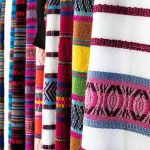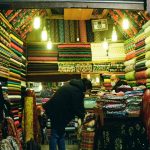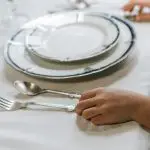When sourcing lace and chiffon in China, focus on fabric types like silk or polyester chiffon and delicate or heavy laces to match your needs. Visit major markets in Guangzhou, Shanghai, and Beijing for variety and competitive pricing. Check quality by examining composition, texture, and durability. Negotiate by comparing suppliers and leveraging bulk orders. Prepare for shipping rules and plan clear communication despite language barriers. Keep exploring to find expert tips on building strong vendor relationships and securing the best deals.
Table of Contents
Key Takeaways
- Visit major textile hubs like Zhongda Market in Guangzhou and South Bund Market in Shanghai for diverse lace and chiffon selections.
- Inspect fabric quality by checking fiber content, texture, durability, and performing burn tests to ensure authenticity.
- Negotiate prices by comparing multiple suppliers, leveraging bulk orders, and timing purchases during off-peak seasons.
- Use clear, simple language supported by visual aids and translation apps to overcome language barriers with vendors.
- Establish long-term relationships through regular communication, timely payments, respect, and face-to-face visits to suppliers.
Understanding Different Types of Lace and Chiffon Fabrics
When exploring lace and chiffon fabrics, you’ll quickly notice a wide variety of textures, patterns, and qualities that suit different needs.
Lace comes in many types, from delicate Chantilly with its fine floral designs to heavier Guipure that offers bold, raised patterns. You’ll find synthetic laces, which are more affordable and durable, and natural fiber laces that feel softer but need more care.
Chiffon, on the other hand, varies mainly by fiber content — silk chiffon is luxurious and sheer, while polyester chiffon offers similar looks with better durability and easier maintenance.
You’ll also see different weights and finishes, which impact drape and transparency. Understanding these differences helps you choose the right fabric for your project, whether you want elegance, durability, or affordability.
Key Textile Markets to Visit in China
Although China’s lace and chiffon fabric markets are vast, several key textile hubs stand out for their range, quality, and competitive prices.
If you’re heading to Guangzhou, don’t miss the Zhongda Fabric Market, known for its extensive selection of delicate lace and flowing chiffon.
Shanghai’s South Bund Fabric Market offers a blend of modern and traditional fabrics, perfect if you want variety and trend-driven designs.
In Beijing, the Silk Market features high-quality fabrics, including elegant lace and chiffon options.
Finally, Shaoxing remains a top destination, famous for its textile industry and affordable prices.
Visiting these markets lets you compare styles, negotiate directly with suppliers, and discover unique fabrics to enhance your collections or projects.
How to Identify Quality Lace and Chiffon Materials
When checking lace and chiffon, start by analyzing the fabric composition to verify authenticity.
Feel the texture and finish carefully to spot any inconsistencies or roughness.
Then, test the material’s durability and stretch to confirm it will hold up well over time.
Fabric Composition Analysis
Understanding fabric composition plays an essential role in identifying quality lace and chiffon materials. When you examine the fiber content, focus on natural fibers like silk or cotton blended with synthetic ones such as nylon or polyester.
High-quality lace often combines fine cotton or silk threads, delivering durability and a delicate appearance. For chiffon, silk chiffon feels smooth and breathable, while synthetic chiffon may feel slightly rougher but offers better wrinkle resistance.
Always check the fabric label or request a sample test to verify composition. You can also perform a burn test carefully: natural fibers smell like burnt hair, synthetics melt and smell like plastic.
Knowing the composition helps you choose fabrics that suit your design needs and guarantees you invest in long-lasting, premium lace and chiffon.
Texture and Finish Check
Since texture and finish directly affect the look and feel of lace and chiffon, you should examine these qualities closely to spot high-quality materials.
For lace, run your fingers gently over the fabric; it should feel smooth yet intricate, with no rough or stiff areas. The embroidery or patterns must be consistent, with clean edges and no loose threads.
For chiffon, check for a soft, lightweight feel that drapes well without feeling flimsy. Its surface should be slightly crisp but not coarse, with a subtle sheen that reflects light evenly.
Avoid fabrics that feel waxy or overly slick, as these often indicate poor finishing.
Durability and Stretch Test
Although lace and chiffon are prized for their delicate appearance, you still need to guarantee they can withstand wear and maintain their shape.
To test durability, gently pull the fabric in different directions. Quality lace should resist tearing and not lose its intricate patterns, while chiffon should bounce back without sagging or stretching out.
Avoid materials that feel brittle or show signs of distortion after stretching. Also, check the seams and edges for secure stitching, which adds to longevity.
Keep in mind that some stretch is normal, especially in lace with elastic blends, but excessive give indicates lower quality.
Performing these simple tests helps you select fabrics that not only look beautiful but also endure regular use without compromising their elegance.
Pricing Trends and How to Get the Best Deals
You’ll notice that pricing for lace and chiffon fabrics can vary based on quality, demand, and supplier location.
Knowing the current market rates helps you spot fair deals and avoid overpaying.
Don’t hesitate to negotiate—suppliers often expect it and may offer discounts with the right approach.
Current Pricing Overview
Many factors influence the current pricing of lace and chiffon fabrics in China, from raw material costs to seasonal demand.
You’ll find prices vary based on fabric quality, design complexity, and order volume. For example, premium lace with intricate embroidery costs more than simpler patterns.
Chiffon pricing fluctuates with fiber type—silk chiffon is pricier than polyester blends.
Keep an eye on market trends, as global supply chain shifts and currency rates also affect costs.
When sourcing, compare quotes from multiple suppliers and consider bulk purchases to secure better rates.
Stay informed about peak seasons, when demand spikes and prices tend to rise.
Negotiation Strategies
Understanding the factors behind lace and chiffon fabric pricing sets you up to negotiate effectively with suppliers. Prices can fluctuate based on material quality, order volume, and seasonal demand. To get the best deals, always compare quotes, ask for discounts on bulk orders, and be ready to walk away if terms don’t suit you.
| Negotiation Tip | Pricing Trend | Outcome |
|---|---|---|
| Leverage bulk orders | Lower unit price | Cost savings |
| Time your purchase | Off-peak discounts | Better rates |
| Build supplier rapport | Flexible payment terms | Enhanced cooperation |
| Confirm quality specs | Avoid hidden costs | Transparent pricing |
Use this approach to secure favorable terms and maintain strong supplier relationships.
Essential Tools and Terms for Fabric Shopping
Steering through China’s lace and chiffon fabric markets becomes much easier when you know the essential tools and terms involved.
Start by carrying a reliable measuring tape to check fabric width and length accurately. A portable light source helps you inspect the fabric’s true color and texture under different lighting.
Carry a measuring tape and portable light to accurately assess fabric dimensions and true colors in varied lighting.
Familiarize yourself with key terms like “denier” (fiber thickness), “gsm” (grams per square meter, indicating fabric weight), and “selvage” (fabric’s finished edge). Knowing fabric types—such as embroidered lace or stretch chiffon—lets you assess quality quickly.
Also, keep a small notebook or app ready to note vendor details and fabric codes. These tools and terms empower you to make informed choices and avoid costly mistakes during your fabric hunt.
Navigating Language Barriers in Chinese Markets
You’ll likely face language challenges when shopping in China’s fabric markets, but clear communication is key.
Using simple phrases, gestures, and translation apps can help you connect with sellers more effectively.
With the right strategies, you’ll navigate conversations smoothly and get the fabrics you want.
Common Language Challenges
Although traversing China’s lace and chiffon fabric markets offers great opportunities, language barriers can quickly complicate your experience. You might find that many vendors speak limited English, making detailed product discussions challenging. Technical fabric terms often don’t translate clearly, leading to misunderstandings about material quality or specifications.
Additionally, regional accents and dialects can further confuse communication, especially in smaller markets. Handwritten labels or packaging might use simplified Chinese characters unfamiliar to you, complicating product identification. Even numbers and pricing can become tricky due to different conventions or verbal expressions.
These common language challenges mean you’ll need to stay patient and attentive, ensuring you accurately grasp essential details before finalizing any purchase. Recognizing these obstacles upfront helps you prepare for smoother interactions in this dynamic market.
Effective Communication Strategies
Overcoming language barriers in China’s lace and chiffon fabric markets requires practical communication strategies. You should focus on clear, simple language and avoid jargon when speaking with suppliers.
Use visual aids like fabric samples, photos, or sketches to convey your needs accurately. Listening actively and confirming details by repeating or summarizing what you’ve heard helps prevent misunderstandings. Don’t hesitate to ask for clarification if something’s unclear—patience goes a long way.
Building relationships also improves communication; regular visits and polite gestures foster trust and openness. Finally, be mindful of cultural differences in communication styles; showing respect and understanding can bridge gaps effectively.
These tactics help you navigate language challenges and secure the quality fabrics you want.
Utilizing Translation Tools
How can you bridge the language gap quickly and accurately when negotiating in China’s lace and chiffon fabric markets?
Utilizing translation tools is your best bet to avoid misunderstandings and maintain smooth communication. Here’s how to make the most of them:
- Use reliable apps like Google Translate or Pleco for instant text and voice translations.
- Prepare key phrases related to fabrics, pricing, and shipping in advance and save them for quick access.
- Employ OCR (optical character recognition) features to translate Chinese text on labels or documents instantly.
- Combine tools with a human translator for complex negotiations to guarantee accuracy and cultural nuance.
Working With Wholesale Suppliers and Manufacturers
When you start working with wholesale suppliers and manufacturers in China’s lace and chiffon fabric markets, building strong relationships is key to securing quality materials and competitive prices.
Communicate clearly about your specifications, order volumes, and deadlines to avoid misunderstandings. Always request samples before committing to large orders, as this helps you verify fabric quality firsthand.
Don’t hesitate to negotiate pricing and payment terms—most suppliers expect some back-and-forth. Keep track of lead times, production capacity, and minimum order quantities to plan your purchases effectively.
Establishing trust through consistent, respectful communication encourages suppliers to prioritize your orders and may grant you access to better deals or exclusive fabrics.
Shipping and Import Considerations for International Buyers
Since importing lace and chiffon fabrics from China involves multiple logistics steps, understanding shipping and import requirements is vital for international buyers.
You’ll want to streamline the process by focusing on key factors:
- Choose the right shipping method: Air freight is faster but pricier; sea freight suits large orders with longer lead times.
- Know your customs regulations: Research import duties, taxes, and paperwork required in your country to avoid delays.
- Verify supplier packaging: Confirm fabrics are securely packed to prevent damage during transit and inspections.
- Track your shipment: Use reliable freight forwarders who provide tracking updates and handle customs clearance efficiently.
Seasonal Trends and New Fabric Collections
Although market demands can shift quickly, staying updated on seasonal trends and new fabric collections is essential for buyers looking to keep their inventory fresh and competitive.
You should monitor China’s fabric fairs and supplier releases closely since manufacturers often debut new lace and chiffon designs aligned with upcoming seasons.
Spring and summer collections typically feature lighter, pastel shades and airy patterns, while autumn and winter bring richer colors and heavier textures. By anticipating these shifts, you can select fabrics that resonate with your target market’s preferences.
Additionally, keeping an eye on emerging trends like eco-friendly materials or innovative weaves guarantees you don’t miss out on popular styles.
Staying proactive lets you offer on-trend products that attract customers and boost your sales throughout the year.
Customization and Private Label Opportunities
If you want to differentiate your product line, exploring customization and private label options in China’s lace and chiffon fabric markets can give you a strong competitive edge.
You can tailor fabrics to your exact specifications, ensuring unique designs that stand out. Many suppliers offer flexible minimum order quantities, making it easier to test new ideas.
Here’s what to focus on:
- Choose fabrics with customizable patterns, colors, and textures.
- Work with vendors who offer private labeling to build your brand identity.
- Confirm lead times and sample availability to avoid delays.
- Negotiate exclusivity agreements to protect your designs.
Tips for Building Long-Term Relationships With Vendors
Building strong, long-term relationships with your vendors can greatly enhance your sourcing success in China’s lace and chiffon fabric markets.
Start by communicating clearly and regularly—keep your vendors updated on your needs and timelines. Show respect for their expertise and listen carefully to their suggestions. Always pay on time and honor agreed terms to build trust.
Communicate clearly, respect expertise, listen well, and always pay on time to build lasting vendor trust.
Visit your suppliers when possible; face-to-face meetings deepen connections and help resolve issues faster. Be transparent about your expectations and provide constructive feedback, but also appreciate their efforts.
Finally, consider volume commitments or repeat orders to demonstrate your loyalty. These steps foster mutual understanding and reliability, turning vendors into partners rather than just suppliers.
This partnership will help you secure better prices, priority production, and quality fabrics consistently.
Frequently Asked Questions
What Are the Best Care Practices for Lace and Chiffon Garments?
You should hand wash lace and chiffon gently in cold water, avoid wringing, and use mild detergent. Always air dry flat away from direct sunlight to prevent damage and maintain their delicate texture and shape.
Can Lace and Chiffon Fabrics Be Used for Upholstery or Home Decor?
Lace and chiffon aren’t ideal for upholstery since they’re delicate and prone to tearing. You can use them for decorative accents like throw pillows or sheer curtains, but avoid heavy-use furniture to keep them looking great.
How Environmentally Friendly Are Lace and Chiffon Fabric Production Methods?
Isn’t it great how delicate lace and chiffon hide their environmental impact? You’ll find they often require lots of water and chemicals. So, if you care, you’ll want to research eco-friendly brands before buying.
Are There Any Health Considerations When Working With Lace and Chiffon Materials?
When you work with lace and chiffon, watch out for dust and fibers that might irritate your skin or lungs. Wearing a mask and gloves can help protect you from allergies or respiratory issues during handling and sewing.
What Are the Historical Origins of Lace and Chiffon Fabrics?
You’ll be amazed to learn lace dates back to 15th-century Europe, showcasing intricate handiwork, while chiffon originated in 18th-century France, prized for its light, sheer elegance. Both fabrics carry rich, timeless stories you’ll appreciate.
- Does Chiffon Fabric Stink - July 15, 2025
- Does Chiffon Fabric Affect the Economy - July 15, 2025
- Does Cotton Fabric Have a Nap - July 15, 2025







